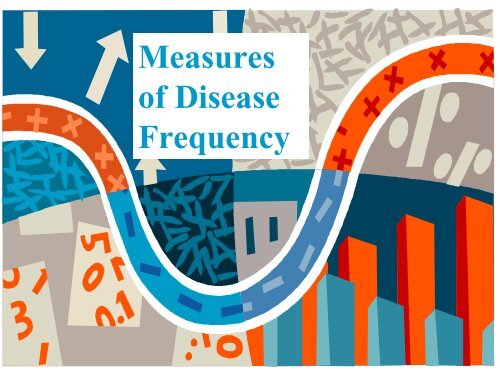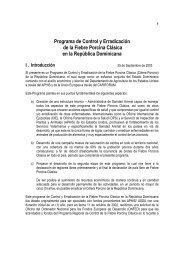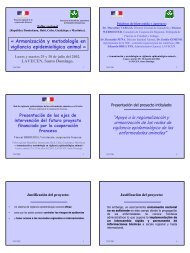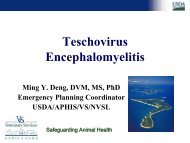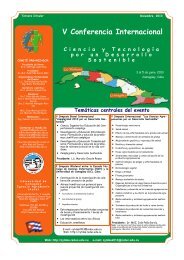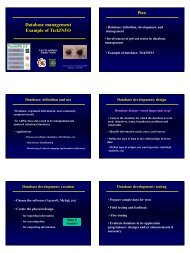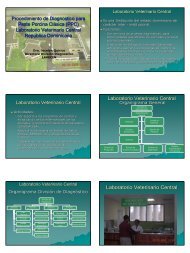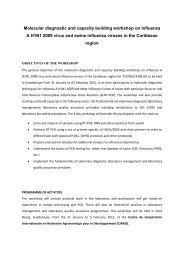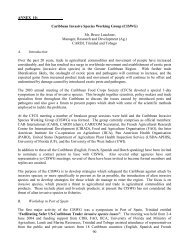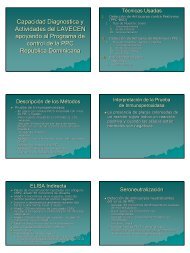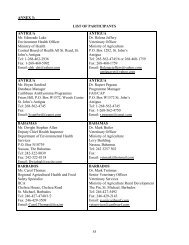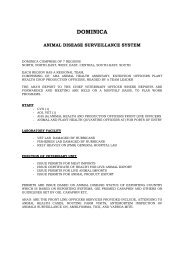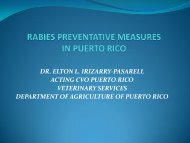Measures of disease frequency - Caribvet
Measures of disease frequency - Caribvet
Measures of disease frequency - Caribvet
You also want an ePaper? Increase the reach of your titles
YUMPU automatically turns print PDFs into web optimized ePapers that Google loves.
<strong>Measures</strong><br />
<strong>of</strong> Disease<br />
Frequency
Why measure <strong>disease</strong><br />
• To quantify or measure the occurrence <strong>of</strong><br />
<strong>disease</strong> is fundamental in understanding:<br />
• Impact <strong>of</strong> <strong>disease</strong> in the population<br />
• Possible associations between factors and<br />
<strong>disease</strong><br />
• Possible mechanisms <strong>of</strong> spread<br />
• Effect <strong>of</strong> control measures
Ratios, Proportions, Rates<br />
• Ratios: the numerator is not included in the<br />
denominator:<br />
a/b (a and b are mutually exclusive)
Ratio Example<br />
Ratio <strong>of</strong> bulls to cows: 2/4= 0.5
Ratio Example<br />
• Feed conversion ratio 3:1 (3 units <strong>of</strong> feed<br />
per each unit in weight gain)<br />
:
Ratios, Proportions, Rates<br />
• Proportions: the numerator is included in the<br />
denominator; they express a fraction:<br />
a/b (a is included in b)
Proportion <strong>of</strong> males in a flock is 3/23 or 0.13
Proportion Example<br />
Proportion <strong>of</strong> bulls in a herd: 2/6= 0.33
Ratios, Proportions, Rates<br />
• Rates: special types <strong>of</strong> proportions; they<br />
express the relationship <strong>of</strong> an event and a<br />
defined population at risk in a specified time<br />
period<br />
a/b<br />
(a is included in b and<br />
b represents population time)
<strong>Measures</strong> <strong>of</strong> <strong>disease</strong><br />
• Prevalence<br />
• Incidence
Prevalence<br />
• Describes what proportion <strong>of</strong> the population is<br />
affected by a <strong>disease</strong> at one point in time<br />
• All cases old and new<br />
• Also called point prevalence<br />
• Defined as:<br />
prevalence =<br />
number <strong>of</strong> cases at time<br />
population at risk<br />
t
Prevalence<br />
Disease duration P= 3/N
Prevalence<br />
Concerns when using this measure:<br />
• Is a static measure<br />
• Only active cases can be included<br />
• Seasonality<br />
• Underestimate<br />
• Short duration<br />
• High fatality<br />
• Sick animals culled<br />
• Overestimate<br />
• Diseases <strong>of</strong> long duration
Incidence<br />
• Frequency <strong>of</strong> new cases during a period <strong>of</strong><br />
time for a population at risk<br />
• Describes the flow <strong>of</strong> individuals from<br />
<strong>disease</strong>-free to <strong>disease</strong>d<br />
• Can use to predict future impact <strong>of</strong> a <strong>disease</strong><br />
• Two measures:<br />
• Cumulative incidence<br />
• Incidence rate
Incidence<br />
(cumulative incidence rate (CIR))<br />
• Proportion <strong>of</strong> a population that becomes<br />
<strong>disease</strong>d during a period <strong>of</strong> time<br />
• Probability <strong>of</strong> developing the <strong>disease</strong> over the<br />
time period<br />
• Length <strong>of</strong> observation period affects CIR<br />
• Usually measured over short periods <strong>of</strong> time<br />
I (CIR) =<br />
number <strong>of</strong> new cases during period<br />
number <strong>of</strong> <strong>disease</strong> free individuals at start <strong>of</strong><br />
period
Incidence Rate<br />
• Also called incidence density rate<br />
• Measure <strong>of</strong> the speed <strong>of</strong> <strong>disease</strong><br />
IR =<br />
sum <strong>of</strong><br />
number <strong>of</strong> new cases<br />
time periods for all <strong>disease</strong> - free individuals<br />
at risk<br />
• Denominator expressed in “animal-time at<br />
risk”<br />
• Example 180 cows, 2 week period = 360 cowweeks
Incidence Rate<br />
• Example: 180 calves are followed for 4 weeks<br />
• 12 develop <strong>disease</strong>, 6 on the 1 st week, 3 on<br />
the second and 3 on the third<br />
• Numerator:<br />
• 12 new cases over the 4 week-period<br />
• Denominator:<br />
• (6 x1)+(3x2)+(3x3)+(168x4)=693 animal-weeks<br />
• IR=12/693=0.017 cases per animal-week
Incidence Rate<br />
Incidence rate = 6 cases/animal time-units<br />
Disease duration
Incidence<br />
Concerns when using this measure:<br />
• Recurrent <strong>disease</strong>s<br />
• Need to find best time interval<br />
• Several ways to define population at risk
Incidence vs Prevalence<br />
Incidence = 6/N Prevalence = 8/N<br />
Disease duration<br />
Observation<br />
period
Crude and specific rates<br />
• Crude incidence rate<br />
• Total number <strong>of</strong> cases and population time at risk<br />
• Ignore the influence <strong>of</strong> host factors or<br />
management<br />
• Specific incidence rate<br />
• Frequency <strong>of</strong> <strong>disease</strong> for specific sub/populations<br />
(age specific, sex specific, etc.)
Incidence vs prevalence<br />
• Prevalence depends on the incidence <strong>of</strong><br />
<strong>disease</strong> and the duration <strong>of</strong> <strong>disease</strong><br />
Prevalence ~ incidence x duration<br />
• For a given incidence, prevalence will be<br />
_____ higher if the duration is long
Other measures <strong>of</strong> <strong>disease</strong><br />
• Case fatality rate/lethality<br />
deaths by cause x<br />
population affected by cause<br />
x<br />
• Cause-specific mortality rate<br />
• Proportional mortality<br />
deaths by cause x<br />
population at risk<br />
deaths by cause x<br />
deaths in the population
Other measures <strong>of</strong> <strong>disease</strong><br />
<strong>frequency</strong><br />
• Attack Rate (really a proportion):<br />
• Number <strong>of</strong> new cases during a specific time period<br />
in a specific group<br />
• Denominator is number <strong>of</strong> animals at risk in the<br />
start <strong>of</strong> an outbreak<br />
• Secondary Attack Rate:<br />
• Proportion <strong>of</strong> cases that develop due to contact<br />
with the primary case
Epidemic Curves<br />
• Plot the <strong>frequency</strong> <strong>of</strong> distribution <strong>of</strong> the<br />
number <strong>of</strong> new cases occurring over time<br />
• Give pictorial information about time and type<br />
<strong>of</strong> exposure, as well as <strong>disease</strong> spread<br />
• Easier to interpret than tables <strong>of</strong> numbers
Propagative epidemic<br />
Endemic <strong>disease</strong><br />
35<br />
10<br />
30<br />
9<br />
25<br />
8<br />
7<br />
casos<br />
20<br />
15<br />
casos<br />
6<br />
5<br />
10<br />
4<br />
3<br />
5<br />
2<br />
0<br />
1 2 3 4 5 6 7 8 9 10<br />
semanas<br />
1<br />
1 2 3 4 5 6 7 8 9 10<br />
semanas<br />
Sporadic <strong>disease</strong><br />
Point epidemic<br />
10<br />
12<br />
10<br />
8<br />
8<br />
6<br />
casos<br />
casos<br />
6<br />
4<br />
4<br />
2<br />
2<br />
0<br />
1 2 3 4 5 6 7 8 9 10<br />
semanas<br />
0<br />
1 2 3 4 5 6 7 8 9 10<br />
Días
200<br />
150<br />
100<br />
50<br />
0<br />
Vesicular Stomatitis in<br />
the United States<br />
1997-2004<br />
Sep<br />
Jan<br />
M ay<br />
Sep<br />
Jan<br />
May<br />
Sep<br />
Jan<br />
May<br />
Sep<br />
J an<br />
May<br />
Sep<br />
Jan<br />
May<br />
Sep<br />
Jan<br />
M ay<br />
Sep<br />
Jan<br />
May
120<br />
100<br />
80<br />
60<br />
40<br />
20<br />
0<br />
apr<br />
jul<br />
oct<br />
jan<br />
Vesicular stomatitis<br />
Colombia 1996-1999<br />
apr<br />
jul<br />
oct<br />
jan<br />
apr<br />
jul<br />
oct<br />
jan<br />
oct<br />
jul<br />
apr<br />
jan<br />
Casos
Temporal Pattern <strong>of</strong> 2003/4 and 2004/5<br />
Temporal Pattern <strong>of</strong> 2003/4 and<br />
AI Epidemics<br />
2004/5 AI Epidemics<br />
300<br />
250<br />
200<br />
150<br />
100<br />
Tet holiday<br />
Feb 9-11, 2004 Tet holiday<br />
Feb 11-13, 2005<br />
no. outbreaks<br />
50<br />
0<br />
10/1/04<br />
10/2/04<br />
10/3/04<br />
10/4/04<br />
10/5/04<br />
10/6/04<br />
10/7/04<br />
10/8/04<br />
10/9/04<br />
10/10/04<br />
10/11/04<br />
10/12/04<br />
10/1/05<br />
10/2/05<br />
10/3/05<br />
Source: Dirk Pfeiffer
BSE in the United Kingdom<br />
40,000<br />
35,000<br />
30,000<br />
25,000<br />
casos<br />
20,000<br />
15,000<br />
10,000<br />
5,000<br />
0<br />
1987 1988 1989 1990 1991 1992 1993 1994 1995 1996 1997 1998 1999 2000
<strong>Measures</strong> <strong>of</strong> Disease<br />
The measures used will depend upon:<br />
• The data available<br />
• The study used<br />
• The type <strong>of</strong> <strong>disease</strong> process being studied


